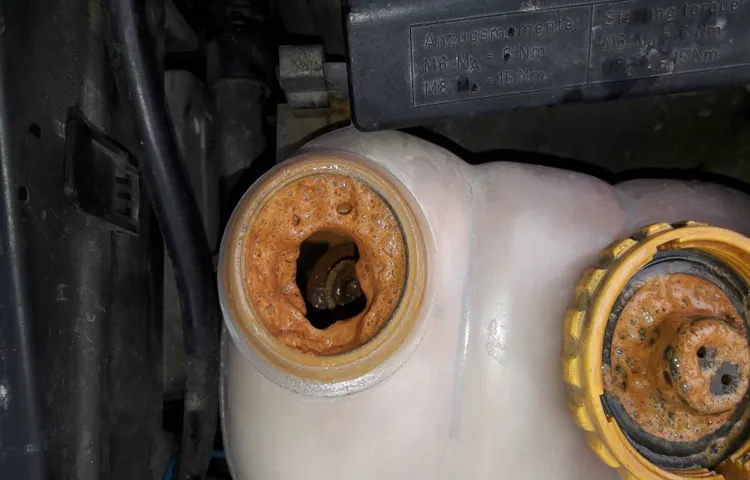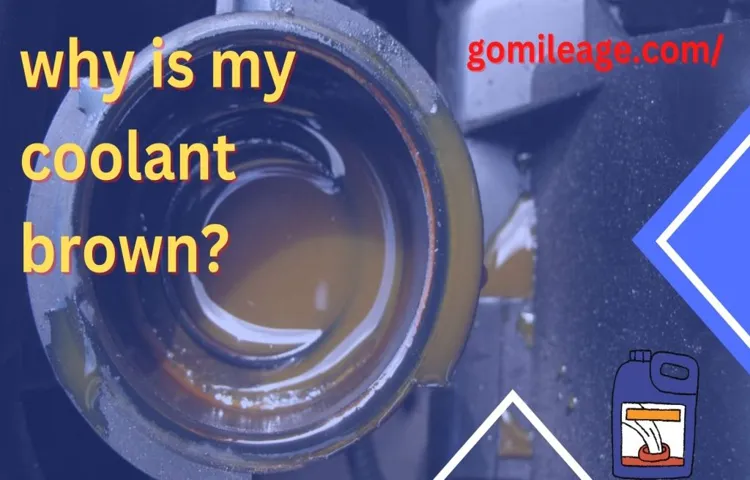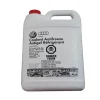Have you ever lifted the hood of your car and noticed that the coolant in the reservoir is not the vibrant green or orange color that it should be? Instead, it’s a murky brown color and thicker than usual. This may raise some concerns and leave you wondering what could be causing this strange phenomenon. Well, fear not! In this blog post, we will explore the possible reasons behind your coolant turning brown and thick, and what steps you can take to resolve the issue.
Think of it as a detective story where we uncover the clues to solve the mystery of the brown and thick coolant. So, let’s dive in and get to the bottom of this automotive puzzle! One possible explanation for your coolant appearing brown and thick is the presence of rust and sediment in your cooling system. Over time, rust particles can accumulate and mix with the coolant, giving it that murky appearance.
This issue is particularly common in older vehicles or those that have not been properly maintained. Rust can develop from the inside of the engine block or radiator and make its way into the coolant. If left untreated, this can cause damage to vital components of your vehicle’s cooling system.
Another culprit behind brown and thick coolant could be an oil leak. If there is a leakage of oil into the coolant system, it can mix with the coolant and create a sludge-like consistency. This is often accompanied by a foul smell and may require immediate attention from a mechanic.
Ignoring an oil leak can lead to engine damage and even complete failure if left untreated for too long. So, it’s important to address the issue as soon as possible to prevent further complications. Additionally, if your coolant has not been changed at regular intervals, it can become contaminated and lose its effectiveness.
Over time, the coolant can break down and lose its ability to properly cool the engine. This can lead to overheating and potential damage to the engine. Therefore, it is vital to follow the manufacturer’s recommended maintenance schedule and have your coolant flushed and replaced regularly.
Table of Contents
Understanding Coolant
If you’ve noticed that your coolant is brown and thick, it’s a clear indication that something isn’t quite right. Coolant, also known as antifreeze, is supposed to be a bright and vibrant color, usually green or orange. When it turns brown and thick, it could be a sign of contamination.
There are several reasons why this might happen. One possibility is that the coolant has been mixed with oil, which can happen if there’s a head gasket leak or a cracked engine block. Another possibility is that the coolant has become oxidized due to exposure to air or other contaminants.
In either case, it’s best to have your vehicle checked by a professional to determine the cause of the issue and prevent any further damage to your engine.
Definition of Coolant
coolant, definition of coolant, understanding coolant

Importance of Coolant in a Vehicle
coolant, vehicle, importance
Common Causes of Brown and Thick Coolant
“Why is My Coolant Brown and Thick?” If you’ve noticed that your coolant has turned brown and has a thick consistency, you might be wondering what could be causing this. Brown and thick coolant can be a sign of several issues with your car’s cooling system. One common cause is a build-up of rust and sediment in the radiator or engine block.
Over time, coolant can break down and become contaminated with rust particles, which can then cause the coolant to turn brown and thicken. Another possible cause is a coolant leak. When coolant leaks into the engine oil or transmission fluid, it can mix with other fluids and create a thick, brown substance.
Additionally, if your car has overheated or experienced a blown head gasket, it can cause coolant to mix with engine oil and create a brown, thick mixture. It’s important to address this issue promptly, as it can lead to further engine damage if left unchecked. Taking your car to a mechanic for a thorough inspection and coolant flush can help determine the exact cause and ensure that your cooling system is working properly.
Rust and Corrosion
“Rust and Corrosion” Have you ever noticed that your coolant has turned a nasty brown color and has become thick and sludgy? Don’t fret, you’re not alone. One of the most common causes of brown and thick coolant is rust and corrosion. Over time, the metal components in your engine can start to break down, causing rust particles to mix with the coolant.
This can make the coolant appear brown and can also cause it to become thick and sludgy. Rust and corrosion can be caused by a variety of factors, such as moisture, heat, and exposure to chemicals. It’s important to address this issue as soon as possible, as rust and corrosion can lead to serious damage to your engine if left untreated.
Regular maintenance and keeping your coolant system clean and well-maintained can help prevent rust and corrosion and keep your coolant clean and clear. So, if you notice that your coolant is looking a bit brown and thick, it’s time to take action and get your engine checked out.
Oil Contamination
One common problem that vehicle owners may encounter is oil contamination in their coolant. This can cause the coolant to turn brown and become thicker than normal. There are several common causes of this issue.
One possibility is a leaking head gasket. The head gasket is responsible for sealing the engine block and cylinder head, and if it becomes damaged or worn out, it can allow oil to leak into the coolant. Another cause could be a cracked engine block or cylinder head.
Similar to a leaking head gasket, a crack in the engine block or cylinder head can allow oil to mix with the coolant. Lastly, a faulty oil cooler can also lead to oil contamination. The oil cooler is responsible for cooling the engine oil, and if it malfunctions, it can allow oil to mix with the coolant.
If you notice brown and thick coolant in your vehicle, it is important to have it checked by a professional mechanic to determine the exact cause and prevent further damage to your engine.
Coolant Additives
“coolant additives” Common Causes of Brown and Thick Coolant Providing the best possible care for your vehicle’s cooling system is crucial to keeping your engine running smoothly. One common issue that car owners may encounter is brown and thick coolant, which can be a sign of underlying problems. There are several possible causes for this issue, including a coolant leak, a failing water pump, or contamination from rust and sediment.
When coolant leaks occur, it can introduce air into the system, leading to overheating and a change in the consistency and color of the coolant. A failing water pump can also cause coolant to become thick and brown, as it fails to circulate properly. Additionally, rust and sediment buildup in the cooling system can cause the coolant to take on a darker, thicker appearance.
To address this issue, it is important to diagnose the root cause and take appropriate action. Regular maintenance, such as flushing the cooling system and using coolant additives, can help prevent and resolve issues with brown and thick coolant.
Effects of Brown and Thick Coolant
If you notice that your coolant has turned brown and thick, it could be a sign of a serious issue with your car’s cooling system. The color change is usually due to the presence of rust or debris in the coolant, which can impede its ability to circulate efficiently. This can lead to overheating and potential engine damage if left untreated.
The thick consistency of the coolant may indicate that it has become contaminated with oil or other substances, further compromising its effectiveness. It’s important to address this issue promptly by flushing and replacing the coolant to prevent further damage to your vehicle. Regular maintenance and inspections can help identify and resolve coolant-related problems before they become more severe.
Impaired Cooling System Performance
One of the most common issues with a cooling system is impaired performance, and one possible cause of this is brown and thick coolant. When coolant becomes dirty and thick, it can negatively affect the efficiency of the cooling system and result in various problems. Firstly, the thickened coolant may struggle to flow properly throughout the engine, leading to inadequate cooling of the hot components.
This can result in overheating and potential damage to the engine. Additionally, the brown sludge can clog up the small pathways and tubes within the cooling system, further limiting the coolant’s ability to properly cool the engine. Ultimately, the impaired cooling system performance can lead to reduced fuel efficiency and increased wear and tear on engine components.
To prevent these issues, it is important to regularly check and change the coolant in your vehicle, ensuring that it remains clean and free from debris.
Increased Engine Wear and Tear
Increased Engine Wear and Tear Have you ever wondered how the condition of your coolant can affect your engine? Well, let me tell you. When your coolant becomes brown and thick, it can lead to increased engine wear and tear. You see, coolant is responsible for keeping your engine cool and preventing it from overheating.
But when the coolant becomes contaminated and loses its effectiveness, it can’t do its job properly. This can cause your engine to run hotter than it should, which puts added stress on the components. Over time, this can lead to increased friction and wear, resulting in premature engine failure.
So, it’s important to regularly check and maintain your coolant to ensure it’s clean and in good condition. By doing so, you can prevent the expensive and inconvenient consequences of engine damage.
Poor Fuel Efficiency
poor fuel efficiency, brown coolant, thick coolant, effects When it comes to improving fuel efficiency in our vehicles, there are many factors that come into play. One often overlooked aspect is the condition of our coolant. The coolant, or antifreeze, in our engines plays a crucial role in maintaining optimal engine temperature, but when it becomes brown and thick, it can have a negative impact on fuel efficiency.
So what exactly are the effects of brown and thick coolant on our fuel efficiency? Well, for starters, when the coolant gets contaminated and turns brown, it is an indication of underlying problems in the engine. This could be due to a coolant leak, a damaged radiator, or even a blown head gasket. These issues can cause the engine to overheat, which in turn affects fuel efficiency.
When the engine is overheating, it has to work harder to function properly, which leads to increased fuel consumption. Thick coolant, on the other hand, can also impede the flow of coolant through the engine. This means that the engine is not getting the proper cooling it needs, resulting in increased friction and heat.
This additional heat can cause the fuel to burn less efficiently, leading to reduced fuel efficiency. In addition to the impact on fuel efficiency, brown and thick coolant can also cause serious damage to the engine. The contaminants in the coolant can clog up the cooling system, leading to overheating and potential engine failure.
This can be a costly repair and can leave you stranded on the side of the road. To prevent these issues and maintain optimal fuel efficiency, it is important to regularly check and flush your coolant. If you notice that your coolant is turning brown or becoming thick, it is a clear indication that something is wrong.
It is best to have your vehicle inspected by a professional mechanic who can diagnose and repair any underlying issues. In conclusion, brown and thick coolant can have a detrimental effect on fuel efficiency. It is important to address these issues promptly to avoid further damage to your engine and prevent costly repairs.
Recommended Actions
If you’ve noticed that your coolant is brown and thick, there could be a few reasons for this. One possible explanation is that there is rust and debris in your cooling system. Over time, the metal components of your engine can corrode, leading to the presence of rust particles in the coolant.
Additionally, dirt and other contaminants can find their way into the cooling system, causing it to become murky and thick. Another potential cause could be a leaking head gasket. A head gasket is a seal located between the engine block and cylinder head, and if it starts to leak, it can allow coolant and engine oil to mix together.
This can result in a sludgy, brown appearance. Lastly, if you haven’t changed your coolant in a long time, it may simply be old and dirty. Coolant should be replaced at regular intervals to maintain its effectiveness in keeping your engine cool and lubricated.
It’s important to address the issue of brown and thick coolant as soon as possible, as it can lead to overheating and engine damage. It is recommended to have your cooling system inspected by a professional mechanic to determine the exact cause and to take appropriate action.
Inspecting the Coolant System
Inspecting the coolant system of your vehicle is an essential part of regular car maintenance. By keeping an eye on the coolant system, you can ensure that your car’s engine stays cool and does not overheat. There are a few recommended actions you can take to keep your coolant system in good condition.
Firstly, it is important to regularly check the coolant levels in the reservoir. This can be done by locating the coolant reservoir and making sure that the coolant is at the appropriate level. Additionally, it is a good idea to inspect the coolant hoses for any signs of wear or leaks.
If you notice any cracks or leaks, it is important to have the hoses replaced as soon as possible. Lastly, you should also inspect the radiator for any debris or blockages. Clearing away any debris from the radiator can help the coolant flow freely and prevent overheating.
By taking these recommended actions, you can help prolong the life of your coolant system and ensure that your engine stays cool.
Flushing and Replacing Coolant
When it comes to maintaining your vehicle’s cooling system, flushing and replacing the coolant is a key step that shouldn’t be overlooked. Over time, the coolant in your radiator can become contaminated with dirt, debris, and other contaminants that can reduce its effectiveness. This can lead to overheating and engine damage if not addressed.
So what should you do? Well, it’s recommended to have your coolant system flushed and the coolant replaced every 30,000 to 50,000 miles or every 2-3 years. This will help remove any build-up and ensure that your engine stays cool and running smoothly. Plus, it’s a relatively simple and affordable maintenance task that can help extend the life of your vehicle.
So don’t put off flushing and replacing your coolant – your engine will thank you for it!
Addressing Underlying Issues
addressing underlying issues, recommended actions. Addressing the underlying issues is crucial when it comes to finding solutions to problems. Rather than just treating the symptoms or surface-level issues, it is important to identify and tackle the root causes.
When it comes to addressing underlying issues, there are several recommended actions that can be taken. First and foremost, it is important to conduct a thorough analysis and assessment of the situation. This may involve gathering data, conducting surveys or interviews, and seeking input from stakeholders.
This will help to paint a clear picture of the problem and its underlying causes. Once the underlying issues have been identified, it is important to develop a comprehensive plan of action. This may involve setting clear goals, establishing a timeline, and assigning responsibilities.
It is also important to gather a diverse group of stakeholders to ensure that all perspectives are taken into account. Finally, it is crucial to regularly evaluate and monitor the progress of the plan. This will help to determine what is working, what needs to be adjusted, and what further actions may be needed.
By taking these recommended actions, addressing the underlying issues becomes a more achievable and effective endeavor.
Conclusion
Well, it seems like your coolant has taken a vacation from its regular duties of keeping your engine cool and decided to indulge in some serious relaxation. In other words, it has transformed itself into a rather unflattering shade of brown and decided to thicken up, just like a rich chocolate pudding. But fear not, for this transformation has a logical explanation.
It’s likely that your coolant has been contaminated with either engine oil or rust particles. Yes, your coolant has been playing host to some uninvited guests, turning it into a gloopy mess. The brown color is a telltale sign of oil contamination, as engine oil tends to darken and deteriorate over time.
This could be due to a leak, a faulty gasket, or perhaps even a mischievous engine trying to add a dash of flavor to your coolant. On the other hand, the thick consistency is a result of rust particles finding their way into the coolant system. Over time, the combination of air, water, and metal can lead to rust formation, causing your coolant to resemble a particularly stubborn mud puddle.
Now, you may be wondering why this matters. Well, for starters, a brown and thick coolant can hinder its ability to properly cool your engine, which can lead to overheating and potential damage. It’s like trying to cool off on a scorching summer day with a melted chocolate bar – it’s just not going to do the trick.
To remedy this situation, it’s essential to address the root cause of the contamination. Have a trusted mechanic check for any leaks, inspect gaskets, and clean out the coolant system of any pesky rust particles. Once your coolant system is back to its pristine state, it’ll be ready to jump back into action and keep your engine cool as a cucumber.
So, remember, if your coolant decides to ditch its usual color and consistency for a brown and thick makeover, it’s time to show it some tough love. Admire its adventurous spirit, but swiftly guide it back to its duty of keeping your engine cool. After all, it’s the coolant’s job to chill, not to indulge in a chocolate spa day.
FAQs
Why is my coolant brown and thick?
Brown and thick coolant can be a sign of contamination. It may indicate that there is rust or sediment in the cooling system, which can lead to clogged radiator, heater core, or water pump. It is important to address this issue promptly to prevent any damage to the engine.
Is brown and thick coolant a serious problem?
Yes, brown and thick coolant should be taken seriously as it can indicate a problem within the cooling system. If left untreated, it can lead to engine overheating and potential damage.
What are the possible causes of brown and thick coolant?
Brown and thick coolant can have several causes, including rust or sediment buildup, engine oil mixing with coolant due to a blown head gasket or cracked engine block, or contamination from a failing transmission cooler.
Can I still drive my vehicle with brown and thick coolant?
It is not recommended to drive your vehicle with brown and thick coolant. This issue should be addressed promptly to prevent further damage to the cooling system and engine.
How can I fix the problem of brown and thick coolant?
To fix the problem of brown and thick coolant, you should have the cooling system flushed and the coolant replaced. It is also important to inspect for any leaks, repair any damaged components, and address the root cause of the contamination.
Can I flush the cooling system myself to remove brown and thick coolant?
While it is possible to flush the cooling system yourself, it is recommended to have it done by a professional mechanic. They have the proper equipment and knowledge to ensure a thorough and effective flush.
How can I prevent brown and thick coolant?
To prevent brown and thick coolant, it is important to perform regular maintenance on your vehicle’s cooling system. This includes flushing the coolant at recommended intervals, using the proper coolant mixture, and addressing any leaks or component issues promptly.



